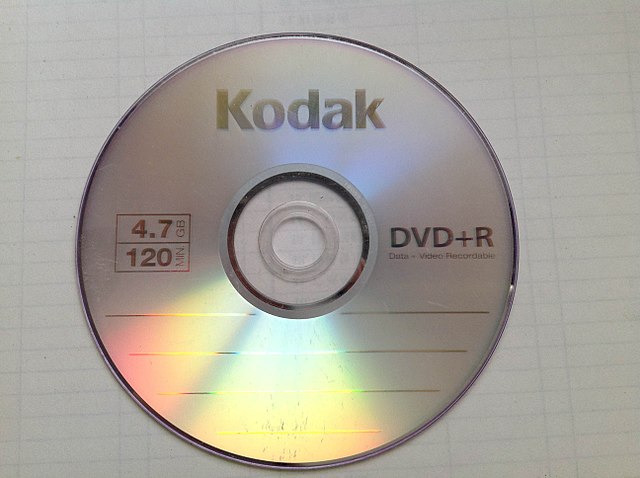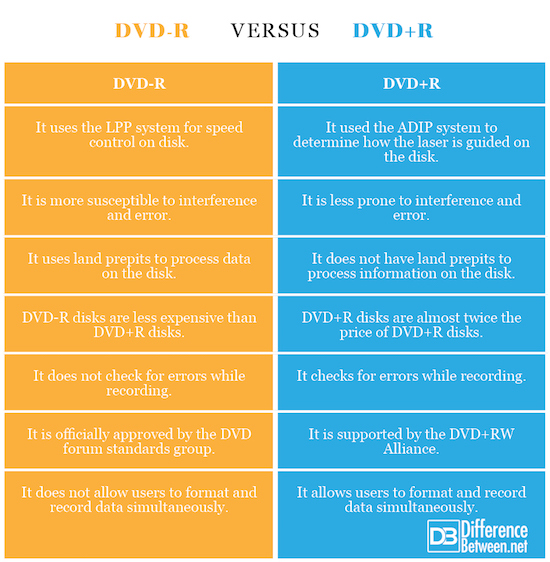Difference Between DVD-R and DVD+R
Not all recordable disc formats are compatible with all DVD players. However, owing to the evolution of technology, now virtually all modern players support all disc formats, allowing you to watch your favorite movies in certain formats supported by your DVD player. DVD has become more than just a technology; it has become a part of our culture. What started as an optical disk storage format has now become the standard for storing digital media in compact disks. As technologies evolved over time, so does DVDs. Just like compact disks (CDs), you could now record, erase, and re-record data into compact disks or digital versatile disks (DVDs). So many different DVD formats have made their way to the digital media ecosystem, out of which the two most common formats are DVD-R and DVD+R. The following article sheds some light on the two of the many flavors of DVDs.
What is DVD-R?
DVD-R, short for “Digital Versatile Disk Recordable” is a common recordable DVD format which looks just the same like a regular DVD, but like a CD-R, it can be used to write data only once but read data arbitrarily many times. It is not a separate DVD format, but rather a shorthand term for a DVD drive that is compatible with all common recordable DVD formats. A basic disk can store up to 4.7 GB of data or media files and a dual-layer disk can store up to 8.5 GB data. The disk can only be used once and cannot be used for recording again when taken out of the drive.
What is DVD+R?
DVD+R is also a recordable DVD format that does not carry the DVD logo as it is not officially approved by the standards group DVD forum. Instead, it is supported by the DVD+RW Alliance. It has a better playback compatibility of about 80 to 80 percent with all DVD players out there. Unlike DVD-R, it uses a ADIP system to determine how laser is guided on the disk to determine the location of the laser beam. Once written, the same disk cannot be used to record data again. They are usually a little expensive than their DVD-R counterparts.
Difference between DVD-R and DVD+R
-
Basic
DVD-R is short for “digital versatile disk recordable”. It is a common DVD format which looks just the same like a regular DVD but with an additional “R” thing which, like a CD-R, can be used to write or record data. But there’s a catch; the DVDs can be written only once but can be read arbitrarily many times. The DVD+R is also a format for recordable DVDs just like a DVD-R or CD-R in which the data can be recorded only once and the data stays on the disk permanently. Both are common recordable DVD formats in which the disks cannot be recorded twice.
-
Format
The DVD-R format is officially approved by the standard groups DVD forum and supported by Pioneer, Samsung, Sony, Toshiba, Fuji, Hitachi, and TDK. The DVD+R format is not officially approved by the standard groups DVD forum but supported by the DVD+RW Alliance, which in fact is supported by Philips, Sony, Yamaha, JP, and Dell. The additional plus format functions at a higher frequency than its DVD-R counterpart. The DVD+R uses an ADIP (Address in Pregroove) disk system which efficiently controls how the laser is guided thereby increasing the speed with which it operates.
-
Functionality
Both the formats look exactly the same on the outside except with some functional differences such as the way they determine the location of the laser on the disk. DVD-R uses tiny marks that are evenly positioned in the grooves of the disk, called land prepits, to determine the position of the laser beam on the disk. There are no land prepits in DVD+R, instead, it measures the wobble frequency to process the information on the disk as laser does. However, new hybrid drives support both DVD-R and DVD+R formats.
-
Features
Although both the formats are created with data usage in mind with almost no technical differences and both are used to store almost same type of data, there are still some differences in the way they record data as specified by the DVD+RW Alliance. The DVD+R format drives are believed to be ejected instantly without having to wait for final formatting, plus it also allows users to format the disk and record data on the already-formatted portions of the disk simultaneously. Another notable feature is that DVD+R formats are compatible with almost all DVD players out there.
DVD-R vs. DVD+R: Comparison Chart
Summary of DVD-R vs. DVD+R
Although both DVD formats are identical on the outside and store almost same type of data with storage capacity up to 13 times of that of a standard compact disk, there are a few functional differences between the two in the way they operate and format. Both are compatible with almost all modern DVD players with the exception of reading speed. Both are competing technologies that use different formats to store data, mostly digital media such as video and audio files. The “-” in DVD-R is a dash, not a minus, so the DVD+R format does not have any inherent advantages over its DVD-R counterpart. Both the formats refer to different ways to get to the same place.
- Difference Between Caucus and Primary - June 18, 2024
- Difference Between PPO and POS - May 30, 2024
- Difference Between RFID and NFC - May 28, 2024
Search DifferenceBetween.net :
Leave a Response
References :
[0]Wroot, Jonathan and Andy Willis. DVD, Blu-ray and Beyond: Navigating Formats and Platforms within Media Consumption. Berlin: Springer, 2017. Print
[1]Noll, A. Michael. The Evolution of Media. Lanham, Maryland: Rowman & Littlefield, 2007. Print
[2]Chambers, Mark L. CD and DVD Recording for Dummies. New Jersey: John Wiley & Sons, 2004. Print
[3]Image credit: https://upload.wikimedia.org/wikipedia/en/thumb/8/8d/Maxell_Branded_DVD-R.JPG/639px-Maxell_Branded_DVD-R.JPG
[4]Image credit: https://upload.wikimedia.org/wikipedia/commons/thumb/e/e7/Kodak_DVD%2BR_disc.jpg/640px-Kodak_DVD%2BR_disc.jpg



